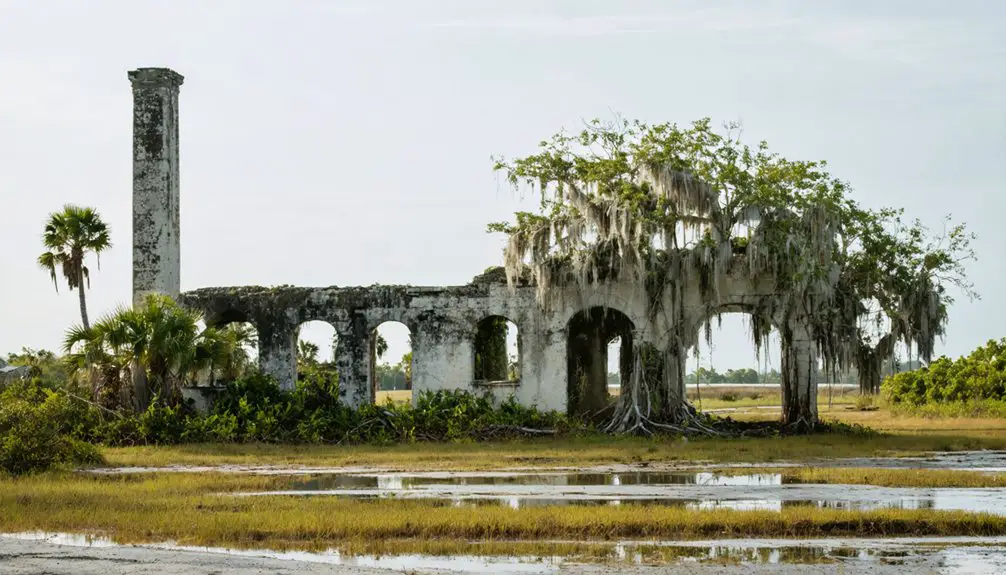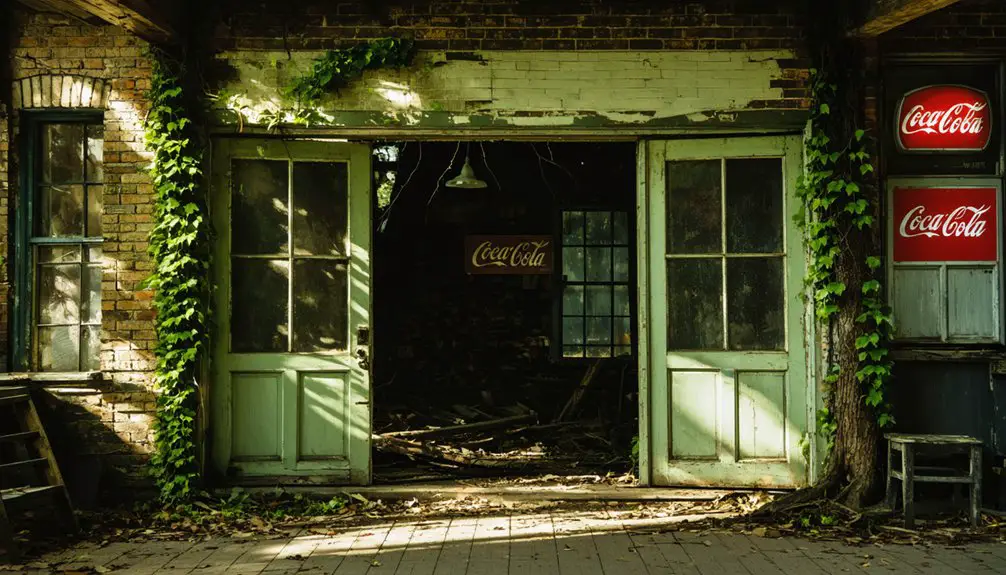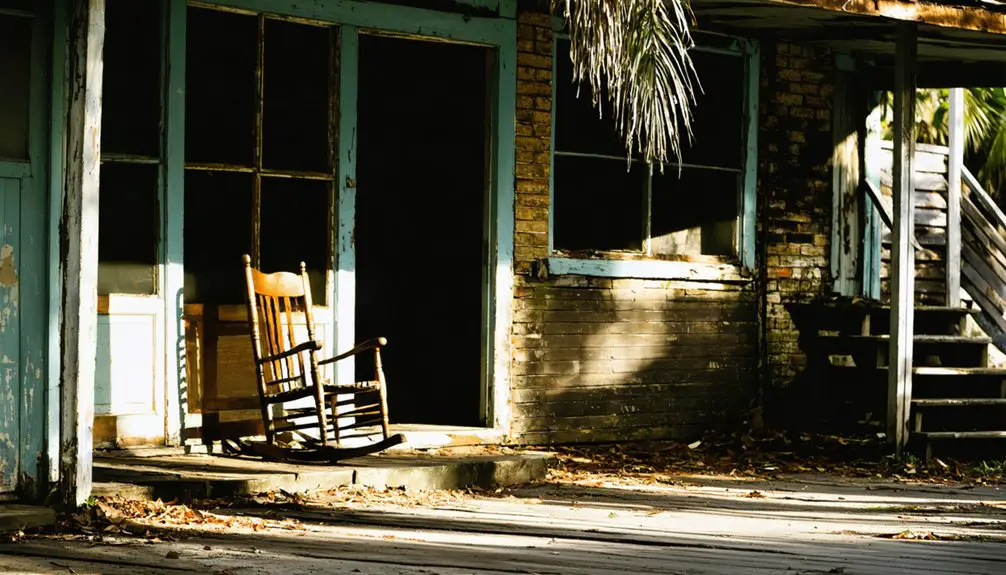You’ll find Gardena’s remnants near Lake Okeechobee in Palm Beach County, where a close-knit farming community of 100 residents once thrived in the late 1800s. The settlement centered around citrus groves, peanut farms, and corn fields, with life revolving around the local church and schoolhouse. The devastating Hurricane of 1928, combined with agricultural setbacks and transportation changes, led to its permanent abandonment. Today, dense vegetation and canal infrastructure mark this lost piece of Florida’s past, though its complete story runs deeper than first appears.
Key Takeaways
- Gardena was a late 1800s agricultural settlement near Lake Okeechobee with about 100 residents focused on citrus groves and farming.
- The Hurricane of 1928 devastated the community, causing widespread destruction and forcing residents to permanently abandon the settlement.
- The town’s economic decline was accelerated by railroad transportation issues and agricultural setbacks, including the Great Freeze of 1894-1895.
- No visible structures remain today, as dense jungle vegetation and saw palmettos have overtaken the abandoned town site.
- The ghost town’s approximate location is near route 827 and Miami Locks canal, but access is restricted due to private property.
The Lost Settlement of Palm Beach County
The agricultural settlement of Gardena once stood near the southern shores of Lake Okeechobee in Palm Beach County, Florida, nestled along historic waterways that served as essential transportation arteries for the region.
Along Lake Okeechobee’s southern edge, Gardena flourished as a farming settlement connected by vital water routes through old Florida.
You’ll find its former location northwest of the Miami Locks canal, near the intersection of the Hillsborough and Bolles Canal route 827.
As you explore Okeechobee agriculture history, you’ll discover that Gardena’s story mirrors that of other vanished communities like Fruitcrest and Okeelanta. The area was part of a vital farming network settlements that contributed to the region’s agricultural development. Local residents used natural resources creatively, including Spanish moss for making pillows and cushions.
The settlement’s existence is documented in Lawrence Will’s “The Cracker History of Okeechobee” and “Everglades River of Grass,” though today you won’t find any physical traces of this once-thriving farming community.
The devastating Hurricane of 1928 wiped Gardena off the map, leaving only historical records to tell its tale.
Historical Significance and Early Development
During the late 1800s, pioneering families carved out a modest agricultural settlement called Gardena near Lake Okeechobee’s southern shore, establishing citrus groves and small farmsteads in Florida’s challenging subtropical environment.
You’ll find that settlement patterns centered around key waterways like the Hillsborough/Bolles Canal and Miami Locks, which provided essential transportation and irrigation opportunities.
Community dynamics revolved around self-sustaining agriculture, with roughly 100 residents working together through local trade networks. Like many ghost towns of the era, residents cultivated peanuts and corn as primary crops.
Similar to how Spanish settlements first established coastal communities in the 1500s, the region’s hot, buggy climate shaped daily life and farming practices, while proximity to settlements like Fruitcrest and Okeelanta created a web of rural commerce.
Like many small Florida farming communities of its era, Gardena’s footprint remains faint, with few historical records documenting its brief existence.
Economic Activities and Community Life
Centralia’s massive sawmill employed over 1,200 workers who’d process timber from the surrounding forests, while you’d find supporting businesses like the well-stocked general store, hotel, and drugstore serving the community’s daily needs.
You’d see workers receiving their pay partly in company scrip, which they’d have to spend at company-controlled stores rather than having full economic freedom.
The town’s social life centered around the community church and schoolhouse, though significantly you wouldn’t find any saloons, as the town maintained a temperance environment with soda pop as the preferred beverage.
Early settlers relied heavily on a diet of pork and wild game for sustenance in the harsh frontier conditions.
The mill’s impressive daily cut capacity of 100,000 board feet of lumber made it one of the largest operations in Florida at the time.
Local Industries and Trade
Dominated by extensive logging operations, Gardena and its neighbor Centralia flourished as bustling timber towns where massive sawmills employed thousands of workers at their peak.
Centralia’s mill alone provided jobs for 1,200 men, drawing laborers from various regions to work the abundant timber resources. The Sherman Mill Company’s presence caused High Coria’s population to surge from 125 to 587 residents by 1930. The logging practices were tightly controlled, with companies often paying workers in scrip redeemable only at company stores, effectively binding them to the corporate economy.
Major timber exports flowed through companies like Southern States Timber Co., which shipped enormous volumes reaching 60 million feet in some locations. The company operated five locomotives and maintained an impressive 50-mile railroad network.
You’d find an extensive network of railroads, including the Atlantic Coast Line, connecting these timber operations to broader markets while supporting secondary industries like phosphate mining and turpentine distilling.
Daily Work Patterns
Life in Gardena revolved around the demanding rhythms of agricultural and forestry work, with residents rising before dawn to maximize productivity in Florida’s subtropical climate.
You’d find daily routines centered on planting and harvesting citrus and vegetables, while forestry workers collected resin and prepared timber for transport. As seasons shifted, so did the labor cycles of the community.
Between agricultural and forestry duties, you’d manage essential household tasks – fetching water, gathering firewood, and preserving food.
The railroad’s arrival and departure times structured your transport schedules, while the local one-room schoolhouse and church services provided rhythm to community life.
You’d rely on traditional remedies and neighbor support for healthcare, adapting your work patterns around the harsh realities of manual labor and weather challenges.
Social Gathering Places
Anyone living in early 20th-century Gardena would have found their social life revolving around makeshift gathering spots typical of Florida’s rural farming settlements.
You’d likely have encountered community gatherings at general stores or churches, where locals exchanged news and traded goods. Just as trending creators draw people together online today, these physical spaces served as hubs for social connection.
The agricultural rhythm of life shaped these informal venues, with seasonal activities determining when people came together.
Here’s how community life typically unfolded:
- Farm workers gathered near canal routes during work breaks
- Families met at shared workspaces during planting and harvest
- Trading and bartering occurred during social meet-ups
- Seasonal celebrations centered around harvest times
The local cypress sawmill operations created additional meeting spots where workers would socialize during their shifts.
After the devastating 1928 hurricane, these gathering places served as essential points for organizing recovery efforts, though they’d eventually be abandoned as the town declined.
Natural Disasters and Environmental Challenges

While many Florida ghost towns faced environmental challenges, Gardena’s fate was sealed by the devastating Hurricane of 1928, which ravaged communities around Lake Okeechobee.
The lack of hurricane recovery efforts left the town vulnerable to nature’s reclamation, as dense jungle vegetation and saw palmettos quickly overtook abandoned structures.
You’ll find that environmental restoration became nearly impossible due to compounding factors: phosphate mine contamination released 215 million gallons of toxic wastewater into nearby waters, while aggressive algae blooms choked Lake Okeechobee.
The humid, corrosive sea air accelerated the decay of remaining buildings, and the persistent chemical runoff from mining operations devastated local ecosystems.
These environmental pressures, combined with annual storm threats, made sustained habitation an insurmountable challenge for Gardena’s residents.
The Path to Abandonment
You’ll find Gardena’s decline followed a pattern common to other Lake Okeechobee farming settlements, where limited economic diversification left the community vulnerable to both market pressures and environmental threats.
The catastrophic 1928 hurricane delivered the decisive blow to Gardena’s struggling agricultural economy, destroying homes, farms, and what little infrastructure existed in the small farming community.
The combination of widespread physical destruction and the exodus of displaced residents marked a point of no return, as the remaining population found rebuilding economically impractical and permanently abandoned the settlement.
Economic Decline Patterns
As Florida’s transportation networks evolved from rail to road in the early 1900s, Gardena experienced a devastating economic decline that would ultimately lead to its abandonment.
The town’s economic vulnerability stemmed from its overdependence on rail transport and agriculture, while lacking the diversity needed to weather major changes.
You’ll find that several key factors accelerated Gardena’s industrial collapse:
- The Orange Belt Railway’s financial instability disrupted crucial transportation links.
- Agricultural setbacks, including the Great Freeze of 1894-1895, devastated local farming.
- New highway systems bypassed the town, isolating it from commercial traffic.
- Supporting businesses shut down as residents sought opportunities elsewhere.
The combination of these economic pressures proved insurmountable, forcing the community to dissolve as transportation patterns and market forces shifted away from railroad-dependent towns.
Natural Disaster Impacts
Natural disasters played a decisive role in Gardena’s path to abandonment, with hurricanes, freezes, and flooding delivering repeated blows to the struggling settlement.
Like many Florida towns of its era, Gardena’s lack of disaster resilience left it vulnerable to nature’s fury. The devastating “Big Freeze” of 1894-1895 struck particularly hard, destroying crucial crops that sustained the local economy.
You’ll find that this pattern mirrors other ghost towns in Marion, Lake, and Sumter counties, where agricultural collapse followed extreme weather events.
Without modern climate adaptation strategies, Gardena couldn’t withstand the recurring assault of storms and floods that damaged its infrastructure.
When hurricanes swept through, they destroyed essential buildings and transportation links, making recovery increasingly difficult.
Each natural disaster accelerated the town’s decline until residents finally chose to relocate elsewhere.
Legacy and Physical Remnants Today

Despite once being a thriving agricultural settlement near Lake Okeechobee, Gardena exists today only in historical records and maps.
This ghost town‘s legacy lives on through academic studies and local historical interpretations, serving as a stark reminder of nature’s power over early Florida settlements.
If you’re looking to explore Gardena’s physical remnants today, you’ll find:
- No visible structures or ruins remain at the site
- The area is now dominated by canal infrastructure
- Access is restricted due to private property
- The location can only be approximated near route 827 and Miami Locks canal
The hot, buggy environment and natural overgrowth have erased all traces of this once-promising farming community, though its story continues to educate visitors about the challenges faced by early Everglades settlers.
Frequently Asked Questions
Are There Any Documented Paranormal Activities or Ghost Stories From Gardena?
You won’t find documented ghost sightings or haunted locations in Gardena. Unlike other Florida ghost towns, there aren’t any verified paranormal activities or supernatural stories linked to this abandoned settlement’s history.
What Native American Tribes Originally Inhabited the Gardena Area?
You’ll find the Seminole tribe, particularly the Alachua Seminoles, dominated this region’s tribal history. They adapted to local wetlands and established cultural significance through their resistance to European expansion.
How Accessible Is Gardena to Modern-Day Visitors and Urban Explorers?
You’ll face significant accessibility challenges since there’s no confirmed location or public access. Urban exploration isn’t currently feasible, and without historical preservation efforts or documented coordinates, visiting remains speculative at best.
Were There Any Notable Crimes or Mysterious Events in Gardena’s History?
Despite searching through a million records, you won’t find any documented historic crimes or unsolved mysteries specific to Gardena. The closest notable criminal activity was Winter Garden’s infamous 1975 Zeigler murders.
What Wild Animals Now Inhabit the Abandoned Town Site?
You’ll find wildlife sightings of white-tailed deer, coyotes, raccoons, and bobcats, while alligators lurk in nearby canals. Birds and reptiles have adapted to the overgrown ruins and abandoned structures.
References
- https://www.youtube.com/watch?v=fAu5kj5Q5uo
- https://www.youtube.com/watch?v=kXGAKmjGMXg
- https://www.tiktok.com/@socialshepherdadventures/video/7342301852702100778
- https://en.wikipedia.org/wiki/List_of_ghost_towns_in_Florida
- https://www.wikiwand.com/en/articles/List_of_ghost_towns_in_Florida
- https://www.ghosttowns.com/states/fl/gardena.html
- https://www.youtube.com/watch?v=Lv9sIPn3NgU
- https://floridatrailblazer.com/category/ghost-towns/page/2/
- https://freepages.history.rootsweb.com/~gtusa/usa/fl.htm
- http://www.fivay.org/centralia.html



